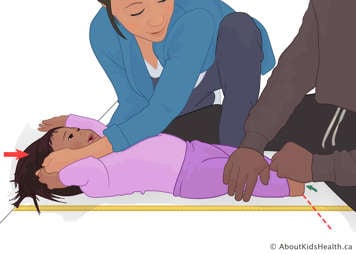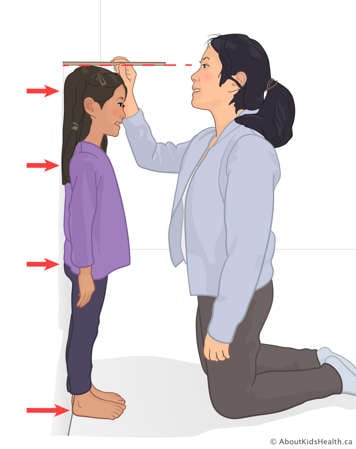Measurements of height and weight are key components in evaluating your child's health status. You should be prepared to provide your child’s most current height and weight measurements to their health-care providers at every visit, as these measurements are often used to calculate medication dosages or nutrition needs.
Preparing to measure height and weight
In order to accurately measure your child’s height and weight, you will need the following supplies:
- A flat, hard surface that is directly against an upright wall or headboard to measure your child’s height while they are lying down; or
- A flat, uncarpeted floor and an upright wall (preferably without baseboards) to measure your child’s height while they are standing up.
- A straight ruler.
- A measuring tape.
- To ensure an accurate measurement, be sure to check where the zero is located on the tape. Some tapes start at zero and others have some lead-in space.
- A pencil.
- A sticky note. This is optional, if you do not want to mark the wall or hard surface.
- A digital weighing scale.
Measuring height
Measuring height if your child is under two years of age
If your child is an infant or under two years of age, their height should be measured while they are lying down. This is a measurement of distance from the top of the head to the soles (heels) of the feet when your child is lying down. It is recommended that this measurement be taken with the help of two caregivers.

To measure your child’s height accurately at home while they are lying down, you will need to:
- Place your child on their back on a flat, firm surface. Your child may remain diapered, but you should remove any bulky clothing. Ensure that the top of your child's head is directly against a flat wall or headboard.
- Have two caregivers obtain the measurement. Two people are required to accurately measure your child’s height; one to hold your child's head straight and flush to the wall, and one to fully stretch your child’s legs.
- Place the measuring tape on the flat surface directly beside your child. It may be helpful to tape the measuring tape to the lying surface.
- Measure the distance from the top of your child’s head to the soles (heels) of their feet.
- Read and record the height to the nearest 0.1 cm.
Note: There may be a difference between measurements of height while lying down and height while standing up of up to 2.5 cm.
Measuring height if your child is two years of age or older
If your child is two years of age or older and can stand and maintain the correct erect posture against a wall, their height should be determined by measuring their height while they are standing up.

To measure your child’s height accurately at home while they are standing up, you will need to:
- Stand your child on a flat, uncarpeted floor with their feet flat, together, and against a vertical wall. The back of their head, shoulder blades, buttocks, and heels should be against the wall. Depending on the overall body shape of your child, all points may not touch the wall.
- Make sure your child’s legs are straight, arms are at their sides, and their shoulders are level. Ensure your child is standing as still as possible.
- Have your child look straight ahead.
- Place a ruler on top of your child's head (refer to image above).
- Have your eyes at the same level as the ruler.
- Mark where the bottom of the ruler meets the wall. Use a measuring tape to measure from the base of the floor to the marked measurement on the wall.
- Read and record the height to the nearest 0.1 cm.
Helpful tips
- Remove shoes, socks, bulky clothing and hair accessories.
- Make sure your child’s hair is down (e.g., no ponytails, buns, etc.).
- Use a sticky note to mark on, instead of the wall or hard surface.
- Repeat all measurements at least twice to ensure they are accurate.
- Be sure to verify if you are measuring in centimetres vs. inches.
Measuring weight
To measure weight accurately at home, you will need to:
- Use a digital scale. Avoid using bathroom scales that are spring-loaded. Place the scale on firm flooring rather than carpet.
- Have your child remove their shoes and heavy clothing.
- Have your child stand/lie as still as possible in the centre of the scale.
- Record your child’s weight to the nearest decimal fraction (e.g., 0.1 kg, 0.1 oz, 0.1 lbs).
Helpful tips
- If your child is too young or unable to stand independently on a scale, you can first independently weigh yourself, then re-weigh yourself while holding your child. You can subtract your independent weight from the combined weight to identify the difference.
- For example: weight of both caregiver and child – weight of caregiver = weight of child alone
- Repeat all measurements at least twice to ensure they are accurate.
- Be sure to verify if you are measuring in pounds vs. kilograms.
References
Centres for Disease Control and Prevention (CDC). Measuring Children's Height and Weight Accurately At Home. Retrieved from: https://www.cdc.gov/healthyweight/assessing/bmi/childrens_bmi/measuring_children.html/
